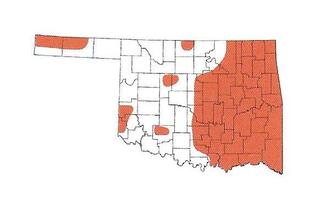Western milksnake
Lampropeltis gentilis
Lampropeltis gentilis
HARMLESS
Description:
Milksnakes are a mess at the moment and we're waiting on the new OK herp field guide to be published in order to get the new taxonomy info.
Size:
Adults 16 - 36 inches (41 - 91 cm)
Prey:
Rodents, lizards, and snakes
Reproduction:
Mates in spring and lays 2 - 20 elongated eggs in June or July. Eggs hatch in 6 - 9 weeks and young are 5 - 12 inches (13 - 30 cm) long.
Habitat:
Open prairies, woodlands, and farmland
Other Information:
The red milksnake is found in the eastern 1/4 of the state, except for extreme southeast Oklahoma.
The central plains milksnake is found in central and western Oklahoma.
The Louisiana milksnake is found only in extreme southeast Oklahoma.
Why doesn't the range map show this species in my county?
Description:
Milksnakes are a mess at the moment and we're waiting on the new OK herp field guide to be published in order to get the new taxonomy info.
Size:
Adults 16 - 36 inches (41 - 91 cm)
Prey:
Rodents, lizards, and snakes
Reproduction:
Mates in spring and lays 2 - 20 elongated eggs in June or July. Eggs hatch in 6 - 9 weeks and young are 5 - 12 inches (13 - 30 cm) long.
Habitat:
Open prairies, woodlands, and farmland
Other Information:
The red milksnake is found in the eastern 1/4 of the state, except for extreme southeast Oklahoma.
The central plains milksnake is found in central and western Oklahoma.
The Louisiana milksnake is found only in extreme southeast Oklahoma.
Why doesn't the range map show this species in my county?
